Garments Steamer Market Research, 2032
The global garments steamer market size was valued at $2.5 billion in 2022, and is projected to reach $4 billion by 2032, growing at a CAGR of 5% from 2023 to 2032.
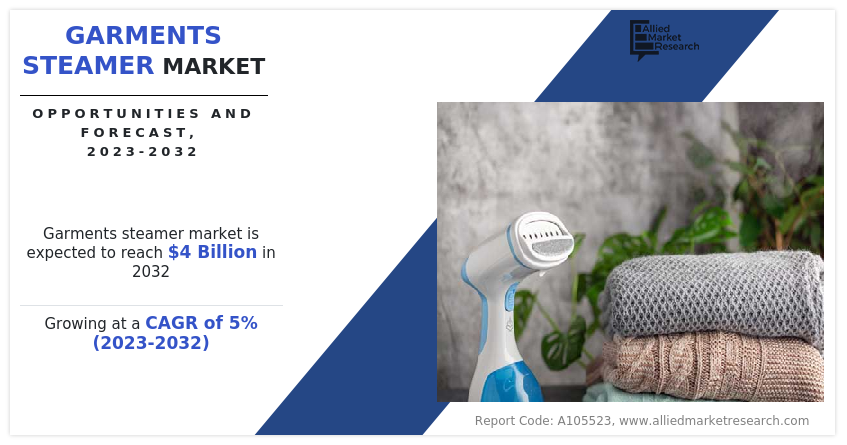
A garment steamer, additionally referred to as a clothing steamer or textile steamer, is a machine that removes wrinkles, freshens, and deodorizes garments and other materials. It is an alternative to typical ironing methods and is especially appropriate for delicate materials like silk, chiffon, and satin, which may be easily ruined by prolonged contact with an iron.
A garment steamer is made up of three parts: a water reservoir, a heating component, and a nozzle. When the gadget is turned on, the heating element warms the water in the tank, transforming it to steam. Steam is subsequently delivered in a regulated manner through the nozzle. The steamer nozzle is moved across the cloth, enabling the steam to permeate the fibers, relax them, and eliminate wrinkles.
Demand for technology-driven appliances has increased in the past few years, owing to the adoption of smart domestic appliances. Consumers are opting for textile care appliances with the latest and advanced features so that these appliances help them with maintaining the quality of their garments effectively. In addition, appliances with advanced technology complement the rise in the living standards of consumers, thus offering convenience and efficiency in their work. Considering the customers’ perception of upgraded textile care appliances, some of the key manufacturers are strategizing on product innovation. For instance, in May 2023, Koninklijke Philips N.V. launched Phillips STE3160 and STE3170 in India. The steamer is equipped with MyEssence technology that allows the user to add fragrance to their garment. Hence, the introduction of key technological advancements in the development of the product is assisting to drive the demand for textile care appliances and garment steamers.
Recent years have witnessed, online shopping as an emerging segment in the sales channel. The world has accepted the usage of digital mediums for shopping. The benefits of online shopping include convenience, time savings, and the ability to access various selections with a single click. With the advent of the COVID-19 pandemic, consumers were forced to shift towards online shopping. According to United Nations Conference on Trade and Development (UNCTAD), in 2021, the e-commerce industry grew, with online retail sales increasing from 16% to 19% of overall retail sales. According to the report, online retail sales by percentage were highest in the Republic of Korea which rose from 20.8% in 2018 to 25.9% in 2021. The increasing percentage shows that consumers are shifting towards online shopping and the popularity of online shopping is rising. The availability of internet access and increasing consumer adoption of online shopping due to its benefits such as convenience, timesaving, and discounted prices are expected to boost the expansion of online channels. The increase in online shopping is expected to increase the sales of garment steamer through digital mediums.
The commercial sector is seeing major market changes as well as higher demand for garment steamers. One important trend is the growing use of garment steamers in businesses such as the hospitality industry, retail, and fashion. Hotels and resorts use garment steamers to swiftly and efficiently steam guest clothing, towels, and uniforms, guaranteeing a clean and appealing appearance. Garment steamers are commonly used in the retail business to eliminate creases from garments, resulting in a maintained properly and appealing presentation for clients. Furthermore, garment steamers are vital equipment for designers, stylists, and runway shows in the fashion business since they are capable of safely steaming delicate textiles without causing harm. Another factor driving business demand for garment steamers is a focus on productivity and effectiveness. Garment steamers provide a speedier and easier alternative to conventional ironing processes, allowing businesses to simplify their operations while meeting their consumers' high expectations.
High prices and the remarkable popularity of household appliance brands have led to the advent of counterfeit brands. Counterfeit brands are generally prevalent in developing economies where customers are highly price-sensitive. This factor restricts the sale of the existing original household appliance brands in these regions. Counterfeit brands are of low quality and often lead to inconvenience & safety issues that subsequently develop negative perceptions among customers. Online sales channel is one of the major platforms, where transaction of counterfeited brands can be easily concealed. Thus, the proliferation of the counterfeited industry is anticipated to hamper the garments steamer market growth.
The growing popularity of garment steamers gives a strong market opportunity for expansion. Demand for garment steamers is expected to grow as more people get acquainted with the advantages and drawbacks of garment steamers against traditional ironing techniques. Effective marketing initiatives, demonstrations of products, and education regarding the ease of use, efficiency, and variety of garment steamers may help raise awareness. Manufacturers may attract the interest of prospective consumers who are looking for affordable and efficient remedies for their fabric care requirements by emphasizing the characteristics that render garment steamers an excellent option for wrinkle removal, such as non-damaging moisture technological advances and appropriateness for delicate fabrics. Furthermore, as customers grow increasingly style-conscious and value well-groomed looks, increased knowledge of garment steamers may result in a shift in consumer tastes and an increasing understanding of these devices as necessary tools for keeping wrinkle-free apparel. Taking advantage of this chance to educate and engage customers about the benefits of garment steamers will help promote market growth and increase the client base.
Market trends and growth opportunities for handheld clothing steamers are substantial in the global market. One notable trend is the growing need for lightweight and easy-to-use clothing care options. Handheld garment steamers are a practical and effective alternative for eliminating wrinkles and rejuvenating garments as customers seek time-saving choices. Handheld steamers are perfect for travel and quick touch-ups because of their small size and low weight. Furthermore, there is a rising awareness of environmentally friendly and sustainable practices. Handheld steamers are a more ecologically friendly solution to traditional ironing since they use less energy and don't require boards for ironing or a high quantity of water. This feature aligns with consumers' growing environmental conscience, thus influencing the sales of handheld garment steamers.
Segmental Overview
The garments steamer market is segmented into type, end user, sales channel and region. By type, the market is classified into handheld and upright. By end user, the market is classified into residential and commercial. By sales channel, the market is classified into supermarkets/hypermarkets, brand outlets, retail stores, e-commerce, and others. Region-wise, the market is analyzed across North America (the U.S., Canada, and Mexico), Europe (France, Germany, the UK, Italy, Spain, Russia, and the Rest of Europe), Asia-Pacific (China, Japan, India, Australia, South Korea, ASEAN, and the rest of Asia-Pacific), and LAMEA (Brazil, Argentina, South Africa, the Middle East, and the rest of LAMEA).
By Type
According to the garments steamer industry, on the basis of type, the upright segment dominated the market in 2022, and is expected to sustain its market share during the forecast period. The increased need for effective and efficient fabric care solutions in both household and business settings is propelling upright garment steamer sales. Upright garment steamers are a strong and adaptable way to remove wrinkles and freshen a variety of materials, including clothes, curtains, and upholstery. They are especially popular among those who have a great amount of clothing or who frequently work with delicate materials that require cautious steaming. Furthermore, upright garment steamers frequently include adjustable settings and numerous attachments, allowing customers to tailor the steaming process to their unique needs.
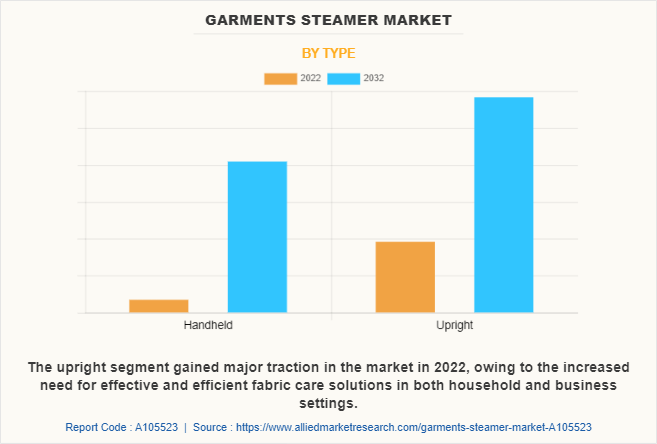
By End User
According to the garments steamer market, on the basis of end user, the residential segment dominated the market in 2022 and is expected to sustain its market share during the garments steamer industry forecast period. There is an increase in the demand for fabric maintenance and cleaning appliances among household end users owing to changes in lifestyle and an increase in disposable income. The market is witnessing a rise in the trend of smart portable appliances among household consumers. Customers are opting for advanced and sophisticated built-in garment steamers, to enhance the effectiveness and provide time-saving solutions. Further, the launch of technology-driven appliances is encouraging consumers to transform their traditional work into smart work.
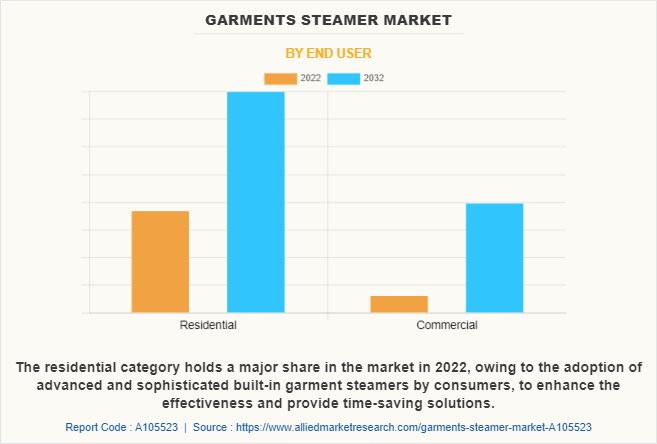
By Sales Channel
According to the garments steamer market demand, on the basis of sales channel, the e-commerce segment dominated the market in 2022 and is expected to sustain its market share during the garments steamer market forecast period. Consumers currently prefer to purchase small appliances online since it is easy and offers a wide variety of brands that are not accessible in stores. Consumers are becoming aware of different purchasing trends that exist in society with the improvement in technology and internet services becoming more readily available.
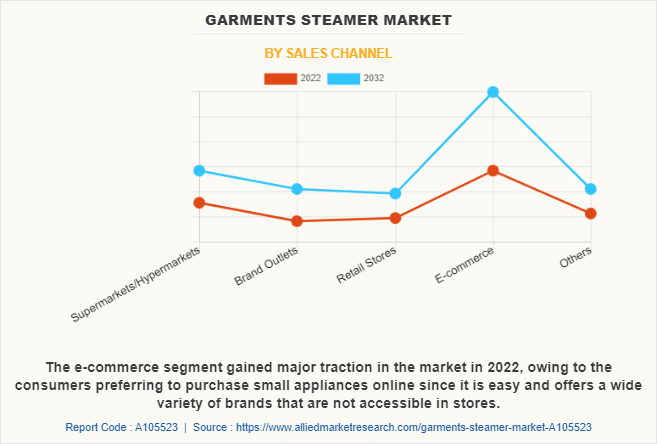
By Region
According to the region, Asia-Pacific dominated the garments steamer market in 2022 and is expected to be dominant during the forecast period. Fabric care appliances are witnessing important shifts in the marketplace that impact their development and potential in Asia-Pacific nations. Fabric care appliances are in high demand because of rising discretionary income and shifting habits among consumers in the region. More families are embracing sophisticated fabric care technologies to satisfy their clothing maintenance demands as economies expand and urbanization develops. Furthermore, as the middle class grows and there is a greater emphasis on personal hygiene and fashion, customers are looking for effective and cost-efficient garment steamers to protect the durability and look of their apparel.
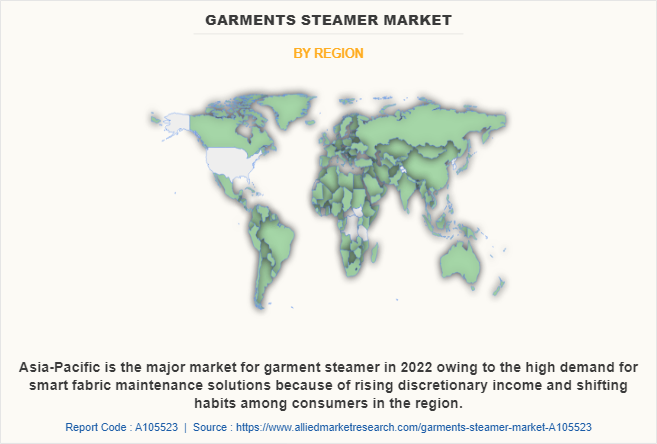
Competition Analysis
Players operating in the global garments steamer market have adopted various developmental strategies to expand their garments steamer market share, increase profitability, and remain competitive in the market. Key players profiled in this report include Conair Corporation, Panasonic Corporation, Pursteam, Groupe SEB, Jiffy Steamer, Reliable Corporation, Electrolux AB, Koninklijke Philips N.V., Haier Group Corporation, and Midea Group.
Some Examples of Acquisition in The Market
In September 2021, Panasonic Holdings Corporation completed acquisition of Blue Yonder in order to expand its portfolio.
Some Examples of Expansion in The Market
In May 2021, Midea Group Co., Ltd. expanded its overseas production of home appliances in North America.
In February 2020, Haier Group Corporation expanded its product portfolio with the launch of 83 new-age products of smart home solutions.
Key Benefits For Stakeholders
- This report provides a quantitative analysis of the market segments, current trends, estimations, and dynamics of the garments steamer market analysis from 2022 to 2032 to identify the prevailing garments steamer market opportunities.
- The market research is offered along with information related to key drivers, restraints, and opportunities.
- Porter's five forces analysis highlights the potency of buyers and suppliers to enable stakeholders make profit-oriented business decisions and strengthen their supplier-buyer network.
- In-depth analysis of the garments steamer market segmentation assists to determine the prevailing market opportunities.
- Major countries in each region are mapped according to their revenue contribution to the global market.
- Market player positioning facilitates benchmarking and provides a clear understanding of the present position of the market players.
- The report includes the analysis of the regional as well as global garments steamer market trends, key players, market segments, application areas, and market growth strategies.
Garments Steamer Market Report Highlights
| Aspects | Details |
| Market Size By 2032 | USD 4 billion |
| Growth Rate | CAGR of 5% |
| Forecast period | 2022 - 2032 |
| Report Pages | 275 |
| By Type |
|
| By End User |
|
| By Sales Channel |
|
| By Region |
|
| Key Market Players | Groupe SEB SA, Pursteam, Reliable Corporation, Panasonic Holdings Corporation, Haier Group Corporation, Jiffy Steamer Company, LLC, Midea Group Co., Ltd., AB Electrolux, Koninklijke Philips N.V. , Conair Corporation |
Analyst Review
According to the CXOs of leading companies, the global garments steamer market is emerging at a considerable pace owing to several factors such as an increase in the compatibility of the appliances, enhanced internet penetration, changes in lifestyle patterns, and growth in concerns about energy prices, all these factors fuel the increase in sales of the smart appliances market.
Changes in the lifestyle of customers have witnessed an increase in the requirement for time-saving solutions, in turn resulting in the development of advanced and innovative fabric care appliances.
The rapid expansion of the retail industry plays a major role in the distribution of garment steamers. It is becoming more important to make appliances available to the consumers. Specialty stores and supermarkets & hypermarkets are gaining major traction in the global market. This is majorly attributed to the availability of enormous options for consumers to choose from. Multi-brand specialty stores have many brands for the single-line product segment, where people can compare their features and colors, which helps them to take buying decisions.
Moreover, Asia-Pacific and LAMEA are projected to register significant growth as compared to the saturated markets of Europe and North America, due to rapid urbanization, increase in penetration of technology even in small cities, growth in disposable income, and improvement in standard of living.
The garment steamer market size was valued at $2,450.0 million in 2022, and is projected to reach $3,984.9 million by 2032, registering a CAGR of 5.0% from 2023 to 2032
The global garment steamer market registered a CAGR of 5.0% from 2023 to 2032.
Raise the query and paste the link of the specific report and our sales executive will revert with the sample.
The forecast period in the garment steamer market report is from 2023 to 2032.
The top companies that hold the market share in the garment steamer market include Conair Corporation, Panasonic Corp, Pursteam, Groupe SEB, and others.
The garment steamer market report has 3 segments. The segments are type, end user, and sales channel.
The emerging countries in the garment steamer market are likely to grow at a CAGR of more than 7.0% from 2023 to 2032.
Post-COVID-19, the garment steamer market is seeing new heights of growth as consumers are aware of the benefits and advantages of using a garment steamer, and the garment steamer manufacturers are likely to increase their sales and profit margin in the next 1-2 years as demand for the products increases.
Asia-Pacific will dominate the garment steamer market by the end of 2032.
Loading Table Of Content...
Loading Research Methodology...


